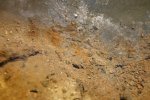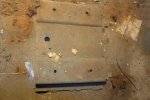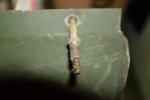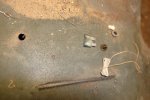Cab floor rust and related mysteries
The rubber floor mat had holes through which we could see rust. As recommended by cucvsrus and others, I removed the rubber and the underlying jute. We definitely have some rust, but I suppose it could be worse.



We haven't started grinding yet. Before we do, I have some questions. Between the seats we have black spots that look like old mildew. I'm inclined to wire brush the mildew away, to provide a clean surface for a new coat of paint. Does this seem like the right approach?
There is a plate welded to the floor at the passenger's feet. It was buried under the mat. Can't see if there's rust beneath it. Can't reach the rust to treat it if it's there. Does this plate serve any purpose? Should I grind away the welds and get rid of it? Does it have any value to anyone? I.e. is it useful to someone?

If you look to the right of the photo above, (right is toward the front of the truck), you can see 2 clumps where the jute still adheres to the floor. The remains of the screws holding the NBC mount remain in their holes under those clumps. I snapped off the heads trying to remove them. I'll take a vice grips to them from underneath and see if I have any better luck from that direction. Assuming they snap off again, what should I do? They're rusted solid to the floor pan, and PB Blaster didn't make a dent. I'm inclined to grind and drill until they're gone, so I can get rid of the rust that surrounds them. Then I figure I'll weld the holes closed and paint with rust reformer and rustoleum. Is that the right approach? Is there a better way?
The "bridge" that runs from the transfer shift lever to the back of the cab is secured in front by 2 bolts. These bolts screw into nuts that seem a little like molly bolts, in that it seems they're intended to expand when tightened. One of these bolts came out easily enough. The other just spun. Clearly the nut on the far end wasn't secured to the floor pan. I used a breaker bar to pull up on the bridge while turning the bolt, hoping to create enough friction on the nut that it would allow the bolt to turn. What actually happened is I pulled the nut through the hole in the floor, never having gotten the bolt to turn relative to the nut. Photos below. How should I reassemble this? I imagine I can get the old nut off with some combination of heat and vice grips. What should I use for reassembly?


These photos show the bolt with the nut still attached, and the 2 holes, one with the nut still in place, and one without. It also shows the artifacts discovered under the jute -- an ace bandage clip, the back for a uniform device, and a 30-amp fuse.
With the seats out, I noticed some rust at the back of the cab, at about head level while seated.


I figure to hit this with a wire brush and rust reformer, unless the experts have a better suggestion.
Below we have 2 mounts for something... I'm curious what they're for. The square plate is on the floor behind the drivers right hip, and the 2 screws are on the back of the cab wall, behind the passenger's left hip.


I presume these are fire extinguisher mounts, just inside the door on each side. Does anyone have a good source for the hardware necessary to secure a fire extinguisher here?

Thanks in advance for all the help. This is my first MV, and I'm trying to do this right.















